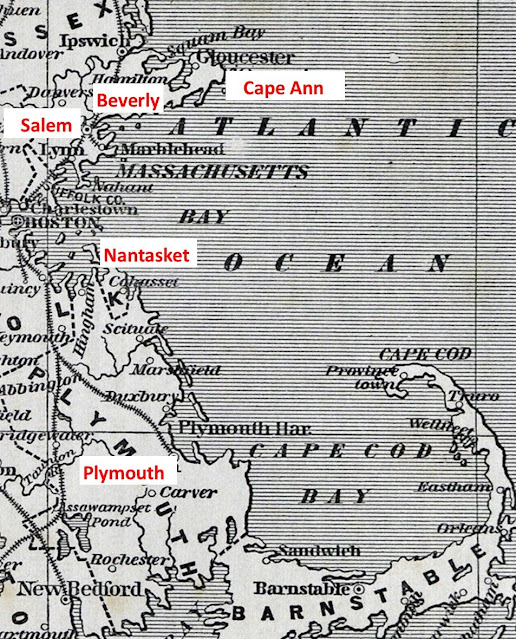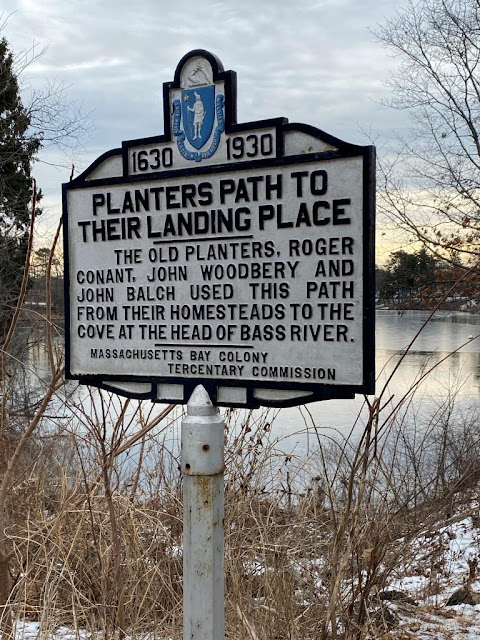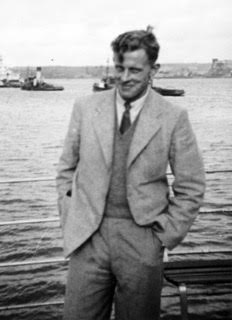AROUND THE TOWN AND OVER THE POND - 06: 'EAST BUDLEIGH'S OTHER GREAT ELIZABETHAN'
Continued from https://budleighpastandpresent.blogspot.com/2024/06/around-town-and-over-pond-05-american.html
AROUND THE TOWN AND OVER THE POND
A walk around Budleigh Salterton to interest transatlantic visitors. Every so often there’s a diversion which may inspire you to visit places like East Budleigh, Exeter, Sidmouth, Colyton or even places in the United States and Canada.
The walk is set out in parts. Here’s the sixth part:
Still at the Raleigh Wall.
0.6 'EAST BUDLEIGH'S OTHER GREAT ELIZABETHAN'
Another blue plaque?
Maybe that Raleigh Wall plaque needs another to mention the two locally born notables who link the Budleigh area to America. Both are closely associated with cities in the US.
The baptismal font in All Saints Church, East Budleigh
Both were born in East Budleigh during the reign of Queen Elizabeth I, but only Roger Conant is
recorded as being baptised in All Saints Church, the date being given as 9
April 1592. So this baptismal font has a special significance for Roger’s
descendants.
Frontispiece illustration from Upper Canada Sketches by Thomas Conant, Toronto: William Briggs 1898. Image credit: www.archive.org
Traditionally, it’s been assumed that his father Richard was the village miller and that the family home was this mill house on Hayes Lane, as pictured in the book Upper Canada Sketches by Thomas Conant.
The author was apparently assured by the vicar of East Budleigh that this mill building was occupied and used by Richard Conant. However no evidence that this was Roger Conant’s birthplace has been found.
It’s more likely that the mill was not the only property owned by Richard Conant, who could be described as a yeoman.
Vicars Mead, on Hayes Lane, East Budleigh
Like Raleigh, Roger may have received his early schooling
from the vicar in the house now known as Vicars Mead.
All Saints Church, East Budleigh. Photo from a guide book
cover
The fathers of both Walter and Roger are recorded as
churchwardens of All Saints, showing that they had considerable status in the
village.
Old Church House in Colyton is one of the many historic
buildings which have thankfully not been destroyed by town planners.
And as was the case with Raleigh, his family had sufficient
influence to obtain a placement for Roger in London. His mother, Agnes née Clarke, was the daughter of John Clarke, a leading merchant
of Colyton in East Devon.
The Feoffees Town
Hall. The building is in Tudor Revival style and dates from 1927
The importance of Roger’s father-in-law is shown in the
mention of ‘John Clarke and others’ who were granted estates in the town by
King Henry VIII on 6 January 1547. The considerable estates had been
confiscated from Henry Courtenay, 1st Marquess of Exeter, whom Henry
had had executed. This was the origin of the Feoffees of Colyton, who continue
to hold local properties and meet in this building.
Salters Hall in St Swithin's Lane, City of London, was home of the Worshipful Company of Salters. There were several buildings on the site, one after another being destroyed by fire. The building seen here was constructed in 1668. Image credit: Old and New London, Volume I, by Walter Thornbury, London 1897. The motto of the Salters' Company on its coat of arms can be translated as 'Salt savours All'
Roger was accepted as an
apprentice with the Salters’ Company, one of the twelve important London livery
companies.
The arms of the Worshipful Company of Grocers, above Grocers’ Hall, as it was restored after the Great Fire of London of 1666. Image credit: The Worshipful Company of Grocers by John Benjamin Heath, London, 1854
His elder brother Christopher was similarly placed, but with
the even more important Grocers’ Company, being accepted as an apprentice to
London grocer Thomas Allen.
St Mary’s Church, Limington
Roger’s brother John was appointed Rector of Limington in Somerset at around this time, and a document dated 20 January 1619/20 relating to the appointment bears Roger’s signature as a witness, confirming his status as ‘salter, of London’.
Members of the Salters’ Company did not
restrict their business to salt, important though it was in the preservation of
food. An example is the salter John Stratford, who traded first in Cheshire cheese and woollen hose from the country, but
then switched to rough flax, linen yarn, wheat, and rye, bought from Baltic
merchants in exchange for English broadcloth. He also experimented with growing tobacco.
The Crypt of St Anne, Blackfriars in the City of London,
1854. Watercolour by Percy William Justyne
Roger and Christopher remained for about ten years in London. During this time Roger married Sarah Horton in St Anne’s Church, Blackfriars, in London. She was the daughter of Thomas Horton, a London merchant who seems to have been a member of the Mercers’ Company, an even more important body than the Grocers and Salters as it was ranked first in order of precedence.
A 19th century engraving showing the meeting of Roger
Conant and Sir Walter Raleigh in East Budleigh. Image credit:
www.lyndon-estate.co.uk
The biography of
Roger Conant by Clifford K. Shipton, published in 1945, gives no specific
reason for Roger’s decision to emigrate to the New World. A tradition that he
may have met and been inspired by a conversation with Sir Walter Raleigh in
East Budleigh is no more than that, with
no evidence for such a meeting. It’s more likely that at a time of economic
decline in England there was talk in the City of London of opportunities for a
new life in America.
John Smith in 1624. Image credit: Wikimedia
That was
certainly the message in a book entitled A Description of New England, published
in 1616 by Captain John Smith. He played an important role in the establishment
of the colony at Jamestown, Virginia, and is also celebrated for the
relationship that he is said to have had with Pocahontas, daughter of a Native
American chief.
Perhaps Roger’s
father-in-law Thomas Horton encouraged him to seek opportunities across the
Atlantic, the Mercers’ Company having been an investor in the Virginian Company
which had supported the Jamestown colony.
This undiscovered world, wrote John Smith, was
‘overgrowen with all sorts of excellent good woodes for building houses, boats,
barks or shippes; with an incredible abundance of most sorts of fish, much
fowle, and sundry sorts of good fruites for mans use’.
John Smith portrayed a life without care for those willing to cross the Atlantic: ‘here are no hard Landlords to racke us with high rents, or extorted fines to consume us, no tedious pleas in law to consume us with their many years disputations for Iustice: no multitudes to occasion such impediments to good orders, as in popular States. So freely hath God & his Majesty bestowed those blessings on they that will attempt to obtaine them, as here every man may be master and owner of his owne labour and land; or the greatest part in a small time. If hee have nothing but his hands, he may set up this trade; and by industrie quickly grow rich; spending but halfe that time wel, wch in England we abuse in idlenes, worse or as ill.’
However, he warned, the colonist embarking on such a life would need to be a superior type of person: ‘It is not a worke for every one, to manage such an affaire as makes a discoverie, and plants a Colony: It requires all the best parts of Art, Judgement, Courage, Honesty, Constancy, Diligence and Industrie, to doe but neere well. Some are more proper for one thing then another; and therein are to be imployed: and nothing breedes more confusion then misplacing and misimploying men in their undertakings.’
This was a recommendation that would no doubt have appealed to the serious-minded Puritans of the time.
The Mayflower II, pictured above, is a replica of the 17th century ship Mayflower,
celebrated for transporting the Pilgrims to the New World. The replica was
built in Devon, England, during 1955–1956, in a collaboration between
Englishman Warwick Charlton and an American museum, Plimoth Plantation,
combining the American museum's ship blueprints with construction by old
traditional methods of English shipbuilders
John Smith's advice to would-be settlers in New England would have appealed especially
to the so-called Separatist Pilgrims who set out from Plymouth in 1620 to cross
the Atlantic in the Mayflower.
'Embarkation of the Pilgrims' (1857) by Robert W. Weir. Photograph courtesy Architect of the Capitol.
Known as Separatists because they wanted a break with the Anglican Church, believing that it was still tainted by Roman Catholicism, they crossed the Atlantic to settle at Plymouth Colony.
Plimoth Plantation, a replica
reconstruction of the original Pilgrim village in Plymouth, Massachusetts,
including the palisade surrounding the settlement. Image credit: Wikipedia
Their intention was to build ‘a
city upon a hill’ - a ‘New Jerusalem’ - that
would shine like an example to the world.
Three years later, Roger and Christopher Conant followed the Mayflower Pilgrims, but as economic migrants rather than for religious reasons. Roger was accompanied by his wife Sarah and baby son Caleb, their first child, a daughter named Sarah, having died in infancy in London.
Map showing the principal places in New England associated with Roger Conant
Roger and his
family remained at Plimoth Plantation for only a short time before moving on to
Nantasket. It has been suggested by some historians that he disliked the
intolerance of the Separatists.
A woodcut
portrait of Rev.John White, from the National Portrait Gallery after an unknown
artist, late 17th century
From Nantasket
he moved on to Cape Ann, near Gloucester, at the invitation of the Rev. John
White, Rector of Dorchester, who had instigated the Dorchester Company of
Adventurers and was a friend of Roger’s brother, the Rev John Conant.
A view of the governor's house after 1792 alterations, as painted by Edward Scrope Shrapnel for Thomas Conant's book, Upper Canada Sketches, (1898). The building was originally located at Cape Ann. Image credit: Wikipedia
Above is where Roger and Sarah Conant may have lived at Cape Ann. Information about the origin of the building, known as the Governor’s House, is scanty, but much of the material came with the party. Some material, such as lumber pieces, may have been produced locally. One later observer mentioned that the framing seemed to have been designed for transportation.
When Roger and Sarah arrived at Cape Ann in 1625, the house was already standing. Their son, Lot, is thought to have been born there.
Detail from Eric Mill's map of North America
published 1712-1714. According to its author, it shows a view of a stage and
the manner of fishing for curing and drying cod on the island of
Newfoundland. Image credit: www.marianopolis.edu
As a member of the London
Salters’ Company, Roger must have seemed to John White ideally suited to supervise the work
at a fishing stage on Cape Ann similar to the one shown above. Such fishing
stages were built for the processing of dried and salted cod, a vital item of
international commerce between the New World and Europe.
The inscription on the marker, embedded in a giant rock, reads: 'On this
site in 1623 the Dorchester Adventurers founded the nucleus of the
Massachusetts Bay Colony, and the fishing industry. Here Roger Conant averted
bloodshed between two factions contending for a fishing stage, a notable
example of arbitration in the beginning of New England.'
Lack of funding caused the Dorchester Company to close by 1625, but its base at Cape Ann is celebrated as the scene of an historic encounter between rival factions on the question of ownership of the fishing stage. Roger, helped by Captain William Peirce, master of the ship Anne which was anchored nearby, played the role of a peacemaker. The event, at what is now known as Stage Fort Park in Gloucester, Massachusetts, was commemorated by the above marker on what is known as Tablet Rock.
Unveiling Tablet Commemorating First Settlement of Massachusetts Bay Colony. 1907 Postcard
Image credit: www.enduringgloucester.com
On one side were West Country fishermen occupying the fishing stage led by John Hewes, representing angry former Dorchester Company investors. On the other was Myles Standish, the military officer of the Plymouth Colonists who claimed ownership of the property, with a force of armed men ready to open fire.
The title page of the 1815 edition of A general
history of New England by Rev William Hubbard
The historian Willam Hubbard is thought to have interviewed Roger Conant in 1682 as part of the research for his book A general history of New England. In Hubbard’s words: ‘The dispute grew to be very hot, and high words passed between them, which might have ended in blows, if not in blood and slaughter had not the prudence and moderation of Mr. Roger Conant, at that time there present, and Mr. Peirse's interposition, that lay just by with his ship, timely prevented. For Mr. Hewes had barricaded his company with hogsheads on the stagehead, while the demandants stood upon the land.’
Budleigh artist John Washington depicted Roger Conant’s mediation in the painting ‘Blessed are the Peacemakers’ (2022), now on display in All Saints Church, East Budleigh
Roger’s intervention, based on
explaining that the fishing stage and its equipment were still the legal
property of the Dorchester Company, was certainly courageous in view of Myles
Standish’s reputation as a firebrand. As Hubbard explains: ‘Captain Standish had
been bred a soldier in the Low Countries, and never entered the school of our
Savior Christ, or of John Baptist, his harbinger, or, if he was ever there, had
forgot his first lessons, to offer violence to no one, and to part with the
cloak rather than needlessly contend for the coat, though taken away without
order. A little chimney is soon fired: so was the Plymouth captain, a man of
very little stature, yet of a very hot and angry temper. The fire of his
passion soon kindled and blown up into a flame by hot words, might easily have
consumed all, had it not been seasonably quenched.’
Myles Standish is revered by many
Americans as the man who ensured the survival of the Plymouth Pilgrims. Works
like Henry Wadsworth Longfellow’s poem The Courtship of Miles Standish
elevated him to the level of folk hero in Victorian America as shown in this
idealized portrait by the American painter N.C. Wyeth, known for his
illustrations of The Last of the Mohicans (1826) and Treasure Island (1883).
Standish’s brutal side is illustrated in this engraving showing him with the head of the Native American warrior Wituwamat impaled on a pike.
Myles Standish Hall was a dormitory at Boston University, originally constructed as the Myles Standish Hotel in 1925. In 2024, Boston University removed Standish's name from the building, citing his brutality.
Realising that the land at Cape Anne was unsuitable for farming some of the settlers were tempted to move to Virginia or even return to England. Roger Conant persuaded them to join him in relocating to Naumkeag, where he had no doubt learnt that farming would be more successful.
As Roger later explained, in words one can read on the above plaque: ‘I was a means through grace assisting me to stop the flight of those few that then were here with me, and that by my utter denial to go away with them, who would have gone either to England, or mostly for Virginia.’
New-Englands
plantation. Or, A short and true description of the commodities and
discommodities of that countrey. Written by Mr. Higgeson, a reuerend diuine now
there resident. Whereunto is added a letter, sent by Mr. Graues an enginere,
out of New-England. London 1680
Roger’s belief that Naumkeag
would be a good choice for a settlement was well founded. The New England
clergyman Francis Higginson, a contemporary of Roger, would write: ‘The
fertilitie of the Soyle is to be admired at, as appeareth in the aboundance of
Grasse that groweth euerie where both verie thicke, verie long, and verie high
in diuers places: but it groweth verie wildly with a great stalke and a broad
and ranker blade, because it neuer had been eaten with Cattle, nor mowed with a
Sythe, and seldome trampled on by foot. It is scarce to be beleeued how our
Kine and Goats, Horses and Hogges doe thriue and prosper here and like well of
this Countrey.’
Naumkeag is a Native American word meaning ‘fishing place’. The name was later changed to Salem, meaning ‘Peace’. Roger and the settlers who remained with him were known as the Old Planters, as shown on the above marker.
Image credit: Teresa Conant
Roger Conant was active in Salem’s civic affairs throughout
his life and is seen in the United States as the founder of the city of Salem.
This bronze statue by the Anglo-American sculptor Sir Henry Hudson Kitson was
installed overlooking Salem Common in 1913 after approval by the Conant Family
Association.
The Conant statue and Witch Museum. Image credit John Andrews
Salem is often called the Witch City because of the Witch Trials which took place after Conant’s death. Unfortunately, and perhaps inevitably, his statue is often mistaken for a witch.
This is not just because of the hat but because of the statue’s location next to the Witch Museum.
Unfortunately, because, as one historian has written, Roger Conant was ‘moderate in his views, tolerant, mild and conciliatory’. It’s an accolade in respect of his fine character which is shared by almost all who have written about him.
Click on the link to continue in Part 7 at
https://budleighpastandpresent.blogspot.com/2024/06/around-town-and-over-pond-07-from.html




















_p037_Roger_Conant's_house,_Salem,_Mass.jpg)














Comments
Post a Comment